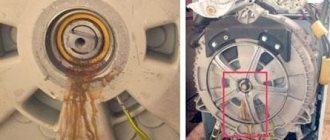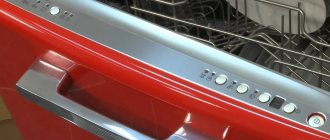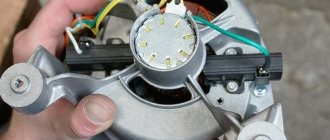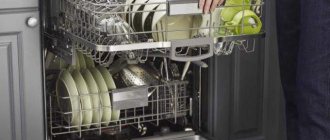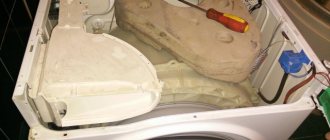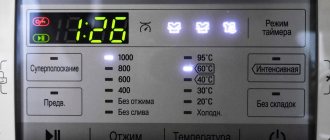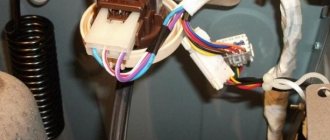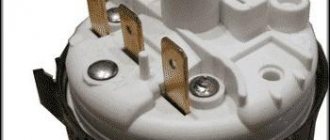Can I fix it myself?
There are many reasons for a Bosch or Indesit dishwasher to break down. Most of the problems arise due to the fact that it is clogged or the drain hose is squeezing. You can solve such problems yourself. However, there are breakdowns that only specialists can handle. As a rule, a malfunction can be caused by the failure of a specific part of the unit or the entire system. In such situations, it will be very difficult to repair the dishwasher yourself.
Common errors and their interpretation
What does the “E1” code mean? This error indicates a heating problem. In this case, a malfunction can be stated:
- water level sensor;
- safety thermostat;
- water flow sensor;
- heating element (reason for lack of resistance);
- control module (reason: power is not supplied to the heater).
Sometimes the “E3” code lights up on a Bosch dishwasher. What does this mean? This error is due to the system being filled with water. So, a Bosch dishwasher can fill liquid slowly or not fill it at all. In this case it could be:
- The dishwasher inlet filter is clogged;
- the drain pump is faulty;
- The Aquastop valve or water level sensor is faulty.
"E27". This error indicates low voltage in the network. Happens often. You should check the voltage at the outlet. Typically, this error occurs during periods of peak load on city power grids. In such a situation, the best way out is to install a special voltage stabilizer.
Main causes of malfunctions
So why does the dishwasher stop and won't drain? This phenomenon may occur due to:
- Filter clogged.
- Kink in the hose through which water is drained.
- Drain system clogged.
- Drain pump clogged or broken.
- Malfunction of the pressure switch.
- Software module malfunction.
Some breakdowns can be solved without the help of a specialist.
It is not necessary to be a specialist and have a good understanding of the structure of the dishwasher. Most of the parts are located at the bottom of the unit. Before starting diagnostics, it is recommended to unplug the device from the outlet. See also -
Dishwasher does not work: do-it-yourself repair
Pinched hose
Very often, the dishwasher does not drain the water due to the hose through which the water is drained being kinked or pinched. This element is usually located behind the unit. The drain hose connects the device to the sewer. Squeezing means that the liquid inside the dishwasher simply has nowhere to go.
To fix the problem, you need to disconnect the device from the power supply and then adjust the hose. After this, you can start the dishwasher again. If the unit still does not drain the water, then the reason lies elsewhere.
What is it for?
Most often, it is necessary to forcefully drain the water from the dishwasher when some technical problems have arisen with it and the machine needs to be repaired. In this case, they try to drain the water completely and as carefully as possible. After all, during the repair process, the case will need to be turned over, and if the water is not drained, it may get on the power board or control module, which will provoke another breakdown. A short circuit on the power board can cause a current leak to the housing, which in turn poses a direct threat to the life and health of users.
In slightly more rare cases, people drain the water from the machine in order to preserve it for the winter. If the Bosch dishwasher is used only in the summer in an unheated room, then leaving it with water during the winter is dangerous. The frozen water inside will rupture the plastic pipes and the machine will have to be seriously repaired in the spring. In general, we have decided on the reasons for draining the water, now let's see how it is done.
Removing liquid from the working machine
We decided that it is only necessary to drain water from a working dishwasher if we decide to preserve the unit until spring. This is what we will proceed from. In order to remove all the water, you need to do the following.
- Select the water drainage program on the control panel.
- We wait until the machine completes it.
- We turn off the power to the dishwasher.
- We turn off the water supply and remove the hoses.
- Place rags on the floor near the right wall of the dishwasher.
- Unscrew the garbage filter and the lid of the salt tank.
- Carefully tilt the machine onto its right side. Some water may still drain out.
- We drag the dishwasher to a warm, well-ventilated place and open the door to let the machine dry inside.
After the above manipulations, the machine can be put away in a dry place. Let her stand quietly until the next season, nothing bad will happen to her now.
Removing liquid from a broken machine
If the dishwasher does not drain the water on its own, then the above method cannot be used. No, well, hypothetically, you can also tilt it on its side, but then not a single liter of water will pour out of the machine, which will certainly flood the power board. However, this measure does not guarantee that all the water will come out of the system, so we offer another solution. What to do?
- We turn off the power and disconnect the machine from water and sewerage.
- Open the door wide.
- We remove the lower basket and take out the garbage filter along with the mesh.
- We unscrew the plug with the ion exchanger tank, where salt is usually poured.
- We take a basin, an IV tube and a syringe. We connect one end of the tube to a syringe, and lower the other into the salt reservoir.
- The trick may not work the first time. Try again, after two or three attempts it will definitely work.
- We suck up the water with the syringe, remove the syringe from the end of the tube and lower this end into the basin. Water should flow by gravity from the salt reservoir into the basin.
- As soon as we manage to drain the water from the ion exchanger tank, we throw the end of the tube into the niche of the garbage filter and perform the same operation.
In this simple way, it is possible to remove almost a drop of water from the machine. Subsequent drying will complete the job and the very next day, you can safely carry out independent repairs or take the dishwasher to a service center.
Why doesn't the machine remove liquid?
Why does water remain in the Bosch dishwasher? Why does the machine stop draining water at one “wonderful” moment? This is usually due to either blockages or malfunctions of the elements responsible for draining water, most often the former. The fact is that many users neglect the basic rules of caring for their “home assistant”. This leads to food debris clogging the garbage filter and water stops circulating, remaining in the washing chamber. Of course, under these conditions, draining it turns out to be impossible.
This problem can be solved very simply. You need to roll up your sleeves, open the washing chamber door, unscrew and rinse the filter and the nearby mesh. After such “spring cleaning” the machine should work normally. It’s worse if the dishwasher does not remove water due to breakdown:
- pumps;
- circulation pump;
- water flow sensor;
- control module.
In this case, you need to immediately contact a specialist. A professional will quickly diagnose, clarify what is broken and repair your “home assistant”, leaving you with valuable recommendations along the way. You should not engage in self-repair, especially in cases where you have absolutely no experience in such matters.
So, removing water from the dishwasher turns out to be quite easy, the main thing is to know a few tricks, and the rest is a matter of technique. We hope our tips are really useful to you. Good luck!
Filter clogged
Most dishwasher manufacturers, such as Bosch, do not recommend loading dishes covered in food debris into the unit. Experts advise washing everything first. Otherwise, the device may break. As a result, it will collect water, but not drain it. Many people neglect this rule, but food particles and small debris can clog the filter.
To eliminate the breakdown, it is recommended to remove the element and clean it. This element is located at the bottom of the dishwasher. The filter must be carefully removed and cleared of any blockages. After this, the part can be returned to its place and the unit can be started.
Drain system clogged
Food residues and debris can create a blockage not only inside the drain hose, but also at the connection to the sewer. As a result of such a clog, the dishwasher will take in water and not drain it. You can fix the problem yourself. To do this, you need to clean the system.
First, you need to disconnect the device from the power supply, and then disconnect the water drain hose at the place where the connection to the sewer occurs. It should be placed in a previously prepared container. After this, the unit must be turned on again and the “Drain” function must be activated. If water flows out of the hose under a large set, then a blockage has formed at the connection with the sewer, and cleaning is required. If the pressure is weak, then the plug is located inside the drain hose.
How to drain water from a dishwasher if it's broken
If a breakdown has been identified in the dishwasher, and the liquid has not drained on its own, then the above method of freeing it from water is unacceptable. As soon as the machine is tilted on its side, not just one liter of water will come out of it, but a significant stream that can flood the power board. Moreover, this does not provide a 100% guarantee of complete drainage of the liquid, so you should use another method:
- as in the previous case, it is worth disconnecting the equipment from the electrical network, as well as from water and sewerage;
- open the door completely;
- remove the lower basket and pull out the garbage filter along with the mesh;
- unscrew the plug from the ion exchanger tank, which is used to add salt;
- We begin to work with a tube, a dropper and a syringe. We connect the tube to the syringe at one end, and the other is lowered into the salt reservoir;
- Using a syringe, we suck in the liquid, remove it from the end of the tube and lower this end into the container. After these manipulations, water will drain from the salt tank on its own;
- As soon as the ion exchanger reservoir is completely emptied of liquid, we insert the same end into the niche from the emptied garbage filter and repeat this procedure again.
If everything is done correctly, the water will completely drain from the dishwasher. Afterwards, you should dry it thoroughly and start repairing it yourself, or take it to a service center.
You can also watch a video with a similar process of draining water:
Debris accumulation in the drain pump
Most often, the dishwasher does not drain water due to a clogged drain pump located at the bottom of the unit. Some models of similar equipment make it easy to remove the part and clean it. However, in some cases, design features do not allow this to be done. To fix the problem, you need to dismantle the element, remove the blockage, and then check the internal impellers. You can use a pencil to determine how they rotate. You should work with extreme caution, as the cork is usually formed as a result of the accumulation of small fragments of dishes, which can easily injure.
If, after removing the blockage, the Bosch dishwasher fills up and does not drain water or does not start at all, then the problem of malfunctions may be much more serious, and it is simply impossible to eliminate it without the help of specialists.
When to contact a service center
If your dishwasher does not drain, the pump may be faulty. In such situations, it needs to be replaced. The water level sensor - pressure switch - can also become unusable. As a result of a breakdown, the software module receives incorrect information about the internal water pressure. The broken part must be replaced with a new one. If this is not done, the dishwasher will not work correctly.
So why does the dishwasher leave water in it? One should not exclude the possibility of a breakdown of the software module itself. This element controls all processes performed by the dishwasher. The software node, if necessary, gives a signal to certain systems to perform basic functions. If it breaks down, the unit will malfunction. If household appliances stop draining water or do not drain it completely, then it is worth diagnosing the software unit. This can be done at the appropriate service center.
Symptoms of a problem
Of course, the main evidence of a lack of normal operation is the water remaining in the washing compartment. But in a Bosch brand dishwasher, its presence can only be determined after the job is completed. Here the liquid is used in a closed cycle, through a filtration system; the pump begins to pump it out at the end of the cycle.
You can verify the malfunction by visual inspection, after stopping work, by opening the washing compartment. Other models, where draining occurs periodically, may stop working without completing the wash. In addition to liquid residues, audio and visual indications can be evidence of a malfunction. On machines without a display, the indicator light and sound signal turn on; if the display is present, the corresponding error code appears on it.
| Car | Error code |
| Bosch | E24 |
| Ariston | TO 03 |
| Electrolux | I20 |
| Candy | E20 |
| Indesit | TO 06 |
| Eyelid | H5 |
In conclusion
If the dishwasher becomes clogged and stops draining water, it is recommended to disconnect the unit from the power supply and check some elements of the systems for blockages.
If the dishwasher does not wash dishes well, this is the first sign that the filter or drain system is clogged. If the cause of the malfunction is not found, then you should seek help from specialists from the service center. You should not leave problems that arise unattended, as this can lead to disastrous consequences. The dishwasher will not drain water. The device will draw water every time it is turned on, which increases the risk of flooding. See also - What are open panel dishwashers
Causes of failure
The entire set of reasons why the machine stopped draining water can be divided into two categories. The first includes circumstances related to installation and operation errors. The second group consists of reasons caused by technical defects.
Installation and operation errors
Most often, defects due to which the dishwasher does not drain water are associated with neglect of the rules of use and care, or errors during self-installation. In this case, even the new device refuses to function normally. The main reasons are as follows:
- improper installation of the drain hose;
- clogged garbage filter;
- clogging of other areas of the drain.
Laying the drain hose
This is the simplest and most easily eliminated reason that needs to be checked first. For normal operation, the hose must have two loops at the connection to the device nozzle and before the connection to the siphon. In this case, bends are not allowed. Their presence blocks the flow, and the absence of loops can cause a siphon effect. In both cases, the pump is unable to pump out water, which leads to its accumulation in the tank. You can restore the work yourself. Required:
- turn off the power;
- reposition the hose in accordance with the instructions;
- restart the device.
Dust filter clogged
If the fluid still refuses to drain normally, the cause of the defect is likely hidden in the debris filter. It is a set of mesh plate and glass, which are screwed into the floor of the washing compartment.
Food residues can gradually clog the filter cells. To clean them, you need to dismantle all the elements and rinse them under running water.
For this purpose you will need:
- remove carts;
- unscrew the filter glass;
- remove the mesh plate;
- wash them using detergent and a brush;
- check the sprinkler rocker arms for blockages and clean them if necessary;
- Reinstall the filter in reverse order.
Blockage in other areas
Cleaning the filter does not always provide a positive result. In this case, it is worth looking for a plug in other elements of the drain system. If the water flows freely after disconnecting the hose from the siphon, the plug is located at the entrance to the sewer and can be removed by regular cleaning. A clogged drain pump will cause much more trouble. To clean it, you must first of all decide how best to drain the accumulated water from a non-working dishwasher. You can drain it by gravity by tilting the device to the side or scoop out the liquid manually. Then:
- remove the inlet hose;
- put the car on its side;
- unscrew the pan;
- remove the level control sensor;
- remove the pump, releasing the fasteners and contacts;
- clean the impeller and volute;
- After cleaning the contacts, check the resistance (standard 200 Ohms);
- Check the pump valve for blockages, if any.
Read also: DIY iron sauna stove
technical issues
When all attempts to eliminate the problem are unsuccessful, the causes of the malfunction should be sought in the failure of the components and assemblies of the device. Despite the reliability of dishwashers, this occurs as a result of natural wear and tear or external factors. Water may not go to the sewer as a result of:
- pump breakdown;
- malfunction of the water level sensor;
- control board failure.
Pump failure
A blockage is not the only possible pump defect. With prolonged and intensive use of the machine, its working life may come to naught. Damage to the impeller may result from contact with solid objects (shards of dishes). The device may burn out due to voltage surges. If, when checking the resistance, there is no voltage from the control board, the part is non-functional and requires replacement.
Sensor malfunction
The level sensor should be triggered when the pan is filled. When defects appear, the signal does not pass through or is distorted. As a result, the pump does not turn on in time. Before replacing, you need to make sure it is working. For this:
- dismantle the pallet according to the scheme described above;
- remove the sensor;
- we check it for a click by blowing through the tube;
- measure the voltage with a multimeter.
The absence of a click and reaction of the arrow on the multimeter scale is a sure sign of breakdown and the need for replacement.
Control module
This is an expensive design element that ensures the sequence of switching modes. It may suffer from short circuits, normal wear and tear, or manufacturing defects. In this case, the module will stop generating the necessary signals in a given sequence, and the machine will become inoperable.
When starting repairs, you should remember that flashing or replacing a board is a complex process, which is not always possible to do independently.
When a breakdown occurs and you are looking for an answer to the question of what to do, you need to correctly assess the complexity of the fault. If problems with blockages can be eliminated with your own hands, then most technical breakdowns require a professional approach. In this case, you cannot do without the participation of a specialist.
No matter how reliable and high-quality household appliances are, no one is immune from breakdowns. As a rule, they happen suddenly. Don't panic - any equipment can malfunction. In today's article we will look at the following problem: the Bosch dishwasher does not drain and it sits in the dishwasher. What to do in this case and for what reason does this situation arise?
